Menu
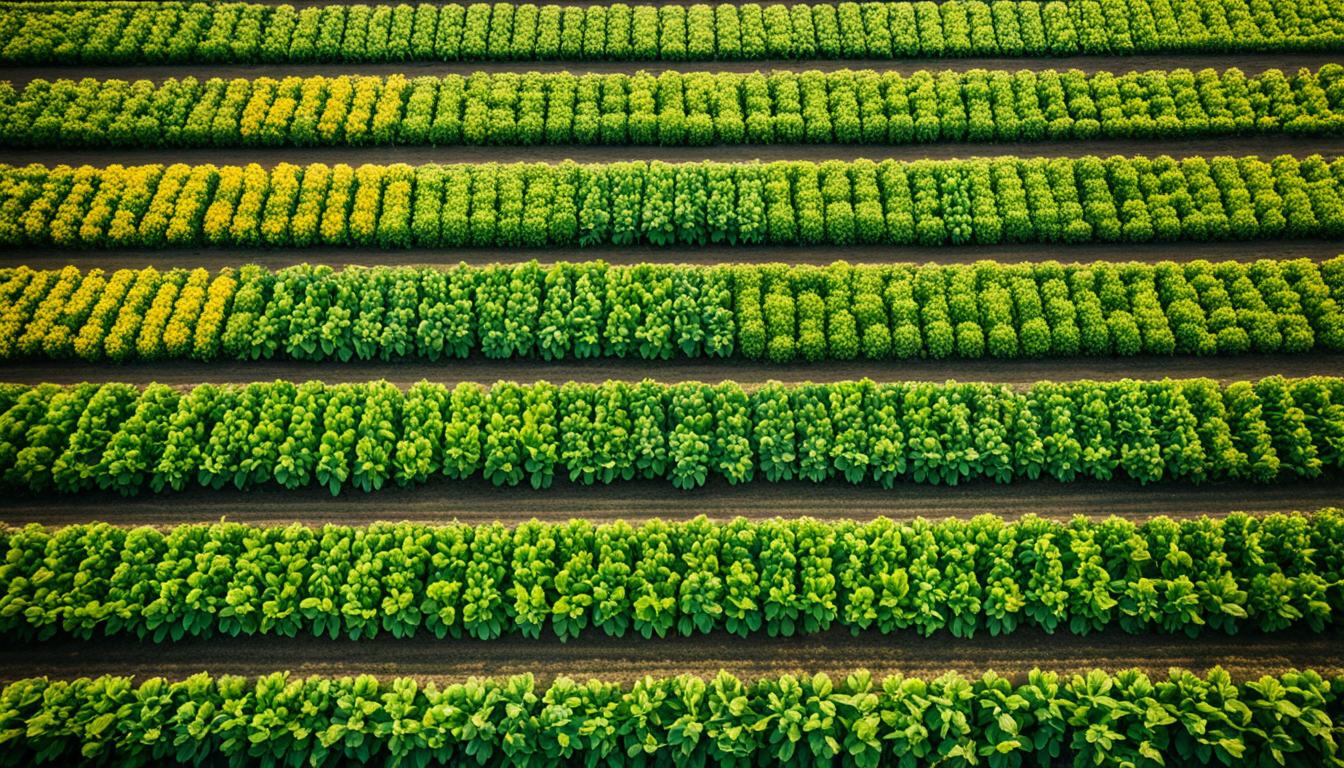
Standing in a vast field of monocultured wheat, I saw how fragile our food system is. Every wind gust reminded me how little plant variety we truly have. Only nine crops feed most of the world. This reliance shows how weak our food security is and how much we risk our ecosystems.
Out of 20,000 edible plants, less than 200 are key in our food supply. This tiny variety makes our agriculture extremely vulnerable to climate change. The need to protect and use this rich biodiversity is crucial. We must ensure our farming can withstand changes in the environment.
The Crop Trust works hard to keep our plant diversity safe. By storing millions of plant varieties in genebanks, we prepare for crises. There are risks, like political unrest and natural disasters, all over the world. But, with efforts like the Emergency Reserve Fund, we can help protect these valuable resources. Stability means more than just saving plants; it secures our ability to farm in the future.
Let’s look at how saving plant variety is key to better food practices. Together, we can show how these efforts will last for generations to come.
Agricultural plant diversity is key in farming. With more types of crops, we’re safer from problems. But nowadays, farms are growing mainly one type of crop, leading to less variety.
This lack of diversity in crops is risky. It makes us fragile against threats like diseases and pests. The problem comes from changing the land, harming our planet.
Scientists think there are about 8.7 million species on Earth. Yet, we’re losing them due to agriculture and other human activities. We’re using more lands for farming, even good ones, turning them into fields. For example, between 2015 and 2016 in the US, 2.5 million acres of land were changed this way. This, together with heavy use of chemicals like neonicotinoids, makes many species disappear.
Cutting down habitats is also a big problem. Places like the Amazon, home to many special species, are being destroyed. About 80 percent of this damage is linked to farming. This is also happening in the US, affecting places like the tallgrass prairies and the species that live there.
These losses are not just bad for the environment. They can also hurt the economy. Farming in the same way over and over, without much variety, makes us easily hit by problems. But if we grow different crops together, we’re safer. This is because diverse plants help each other fight off pests naturally. In fact, almost all insects in the world help us or do no harm.
Having a lot of different plants can also help make more food and money. Some plants, with the help of special fungi, can make the soil richer and help plants grow better. This boosts the production of all plants. This is good for business and farming.
| Factor | Impact |
|---|---|
| Monocultures | Susceptible to diseases and pests |
| Diverse Plant Communities | Natural pest control, increased biomass |
| Habitat Conversion | Biodiversity loss |
| Biodiverse Systems | Improved forage production and profits |
So, it’s clear that we must protect and use more kinds of crops in farming. This helps the economy and the environment. We need to find ways to farm that keep us and our planet healthy.
The world needs sustainable agriculture more than before. Climate change and losing plant and animal species are big threats to farming. Yet, having many different plants helps farms and the environment stay healthy.
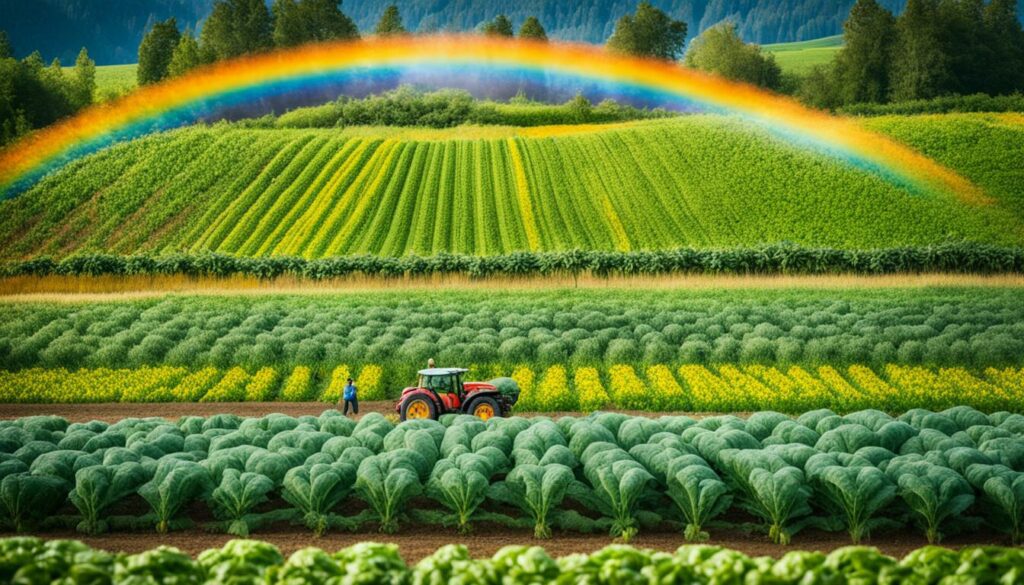
The world is seeing more climate problems. Just a three-degree temperature rise could mean big trouble for many animals. A wide range of plants can survive these tough times. They help keep our food stable in a changing climate.
We’re now relying heavily on just a few plants for food. This means less variety and less nutrition in our food. Growing many types of plants makes sure our food is full of health-boosting vitamins and minerals. It’s key to keeping people healthy, especially in places where food is scarce.
A mix of plants on the farm is great for nature too. It helps the soil, absorbs carbon, and supports the pollinators and pest-eaters we need. This means using fewer harmful chemicals in farming. In the long run, it’s better for farm health and our planet.
Many animals are disappearing rapidly, especially in Latin America, the Caribbean, and in freshwater areas. This is mainly happening in places people use for farming. It shows why we must protect plant and animal life better.
| Region | Biodiversity Decline (%) |
|---|---|
| Latin America & Caribbean | 70% |
| Freshwater Species | 70% |
We must make plant diversity a key part of farming to survive the future. It helps in many ways, from battling climate change to saving species. This shows the critical role of diverse plants in farming today.
Keeping a wide variety of crops is essential for food security. The loss of 75% of the world’s plant types used in farming since 1900 is a big warning. Saving many plant types and their traits helps keep food steady against different changes.
More than half the calories we get from plants come from rice, wheat, and maize. It’s critical to grow other crops too. Take Thailand for example. It went down from 16,000 types of rice to just 37. This drop raises the chance of not having enough food and endangers food security.
There are over 1,750 places worldwide saving over 7 million crop samples. This stock is vital for making new plant types that fight off diseases and survive droughts. It helps make sure we always have enough food.
Choosing old and local plant types often keeps crop variety rich. Many studies show these traditional farming methods are good at retaining crop diversity over the years. This shows how dependable traditional ways are.
The role of crop diversity does more than save cultures. It also aids in making better crops. For example, we can grow plants that fight off bugs, don’t get sick easily, and can live in very hot or dry places better.
To understand this more effectively, consider the following data:
| Aspect | Data |
|---|---|
| Genetic loss since 1900 | 75% |
| Current rice varieties in Thailand | 37 (down from 16,000) |
| Studies reporting diversity change | 95% |
| Studies showing diversity loss | 80% |
| Worldwide genebanks | 1,750 |
| Genebank samples | Over 7 million |
| Edible plant species on Earth | 300,000 |
| Species humans consume | 200 |
| Potato varieties | Over 4,000 |
| Primary calorie sources (crops) | 3 (rice, wheat, maize) |
Genebanks are crucial for saving the world’s plant variety, keeping the essential seeds safe for future use. They do more than just store seeds. They make sure a wide range of plant types are available for years to come. This helps solve problems in farming around the world.
For 40 years, CGIAR Research Centers have been saving crop varieties for people to eat. They have collected over 773,112 types of crops. This includes genebanks with about 7.4 million different plants. Thanks to this work, experts can continue improving our food. CGIAR genebanks send out about 100,000 plant samples every year around the globe, helping fight hunger in many countries.
The Genebank Platform supports these efforts by improving how we save seeds and by making better rules. It’s a six-year scheme set to make genebanks even more effective.
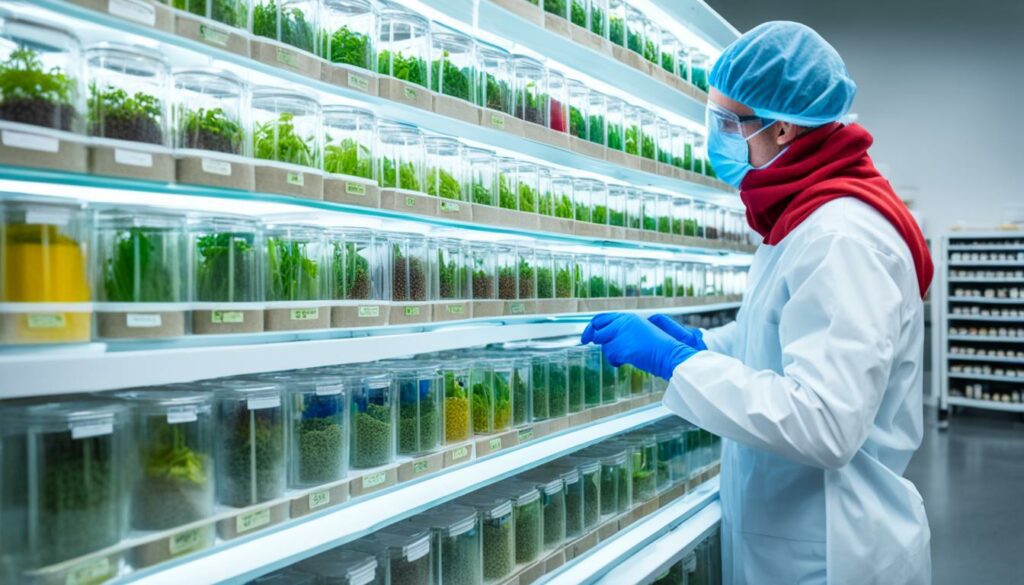
Genebanks have many challenges. They’re under threat from natural disasters like earthquakes and floods. Problems like political upheaval and money troubles also make their work harder. Some genebanks in Asia and the Pacific are often hit by natural disasters, while others in Africa and Asia deal with political issues.
Genebanks are trying to prepare by having duplicate seeds, insurance, and even emergency funds. But, ensuring their contents are properly insured is complex. Experts need to find new ways to evaluate the genebanks for insurance. So, there’s a big need for innovative ways to protect these crucial stores of seeds.
Many genebanks have done great work in saving crops. The Svalbard Global Seed Vault in Norway is a standout. It can store up to 2.5 billion seeds from 4.5 million types of crops. It acts as a safety net for genebanks worldwide. This shows how different countries can come together to safeguard our plant variety.
The Bioversity/CIAT genebank, part of the CGIAR group, preserves over 760,000 types of crops. Efforts like HarvestPlus and CGIAR have led to the development of 240 new, highly nutritious crops. Such successes prove the importance of well-managed genebanks.
Keeping our farm systems sustainable is key. This involves saving genetic variety where crops naturally grow, of saving seeds on farms. Both ways help crops to change when needed, like dealing with new weather.
Conservation in situ is about keeping plant genes safe right where they grow. It supports the idea that keeping nature as it is helps crops get better. This way, plants can keep up with the world without us always needing to change them.
Also, saving seeds on farms means plants can stay close to their roots. This helps keep alive the ways of farming and the plants that have been there for ages. It makes sure these old ways help new generations of farmers.
Keeping plant kinds is more than saving seeds. It’s about making sure farming can always adjust and last. We know a lot of plants mean a lot of ways to keep them healthy. But, some ways of farming overlook many of these plants, making it hard to keep them around.
| Benefit | In Situ Conservation | On-farm Genetic Diversity |
|---|---|---|
| Adaptability | Enhances evolution in natural settings | Facilitates adaptability to local conditions |
| Resilience | Strengthens ecosystem resilience | Boosts farm resilience to environmental changes |
| Participation | Involves community stewardship | Requires active farmer engagement |
Looking after crop variety matters a lot, both for money and the planet. A big part of this is about dealing with changing climate. When crops can naturally handle weather, the risk is lower for farmers.
Science also tells us that looking at plant genes closely can really help farming be better. By understanding more about plant families, we can make farms stronger. But, we’re losing some wild plants, which is a worry.
In the end, saving plant varieties in their homes and on farms is very important. This makes sure we can farm in good ways for a long time. It helps keep farming strong and able to deal with whatever comes its way.
In recent years, the world has put a significant focus on enhancing agricultural biodiversity. This focus has led us to use ecosystem approaches to create plans, keeping our biodiversity safe. This method does more than conserve; it also lets us make the most of our natural variety. It’s based on the idea that everything is connected and humans are part of nature.

The ecosystem approach has 12 core principles which the Convention on Biological Diversity (CBD) has defined. These principles are key for biodiversity management. They cover integrating people’s choices, local ways of handling things, and understanding the economics of using the land and sea. It’s also about making sure the basic parts of our ecosystems, like water and soil, keep working well.
These principles help us manage our land, water, and natural resources in a fair and lasting way.
To succeed, we need practical strategies for using the ecosystem approach in farming. Several methods are very effective for good biodiversity management:
Having a lot of different life in our farming helps it grow better and healthier. The ecosystem approach favours looking after our lands and seas in the long run. This way, we ensure our plants, animals, and the places they live in stay healthy and rich.
| Strategy | Benefits |
|---|---|
| Crop-genetic diversity | Sustains production levels and nutritional diversity across varying conditions |
| Non-disturbance practices | Enhances biological activity and biodiversity in production systems |
| Fragmented land management | Improves yield through enhanced pollination and biological processes |
It’s also very important to work together with others who care about nature and our land. By joining efforts with groups focused on saving nature and farming well, we can do better. Our dedication to these efforts will make sure we leave a good, green Earth for those who come after us.
Monoculture farming means growing just one type of crop over large areas. This method greatly endangers plant diversity. A big example is the 1970 corn blight: using a high-yield corn killed 15% of North America’s corn. This shows the risks of planting the same thing everywhere.
Monoculture’s big problem is the loss of different plants in an area. This harms nature in many ways. It makes the soil sick and leads to more chemicals being used. This hurts the bees and other pollinators we need to grow food worldwide.
Our food system is a major source of the gases causing climate change. This makes growing crops harder. NASA warns that by 2030, warming could seriously cut down corn and wheat in the US. Yet, we’ll need more food for the almost 10 billion people coming by 2050. This makes the debate on monocultures more serious.
Healthy farming like using no-till methods and compost can help. They make the soil better and lock away CO2. This could lessen the harm of climate change. If we use these ways, we might create a better, lasting way to grow food.
| Statistics | Description |
|---|---|
| 70% of corn crops in 1970 | Led to the destruction of over 15% of North America’s corn crops |
| Monoculture farming impact | Destroying crucial pollinators like bees |
| Anthropogenic GHG emissions | One-third originate from the food industry, including monocultures |
| Population by 2050 | Estimated to reach 9.7 billion, driving the need for higher crop yields |
| Regenerative agriculture | Methods include no-till farming, composting, and organic cropping to mitigate monoculture impacts |
| NASA predictions | Direct impact on corn and wheat production in the US by 2030 due to GHG emissions |
Maximising plant diversity helps us fight climate change. Having lots of different plant types helps crops survive bad weather and changing climates.
For a long time, farming has hurt the environment by destroying habitats and polluting. Converting large areas into only one type of crop, like for making biofuels, reduces overall diversity. This makes our food sources less stable and more at risk from pests and diseases.
Different crops make food supplies safer, which is really important. They help protect against the downsides of relying too much on just one kind of crop, like losing soil health. Having a wide variety of plant genes is key in fighting off diseases and adapting to a changing climate.
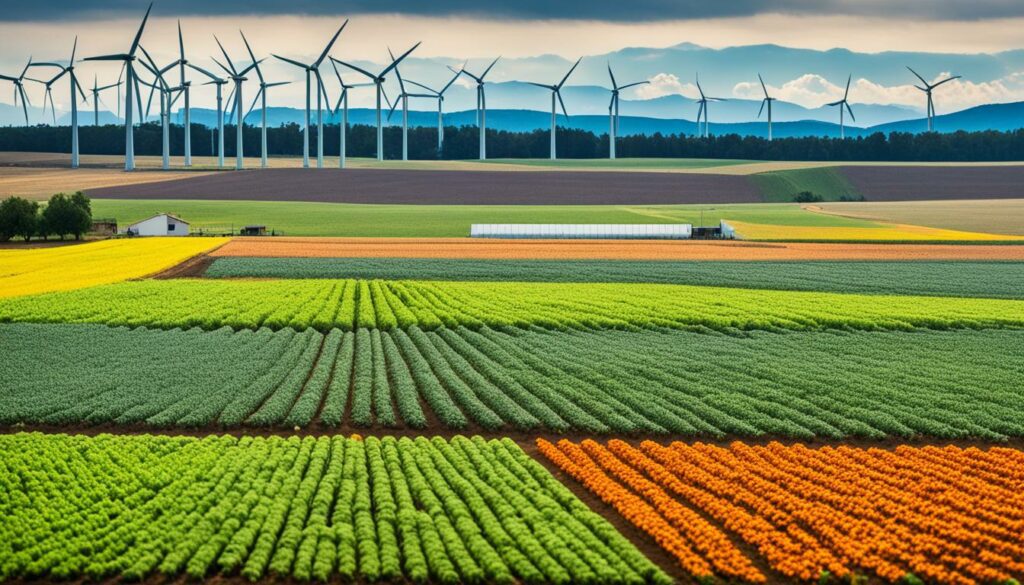
Having a wide range of plants benefits farms in many ways. It attracts helpful insects to pollinate, keeps pests in check, and makes the soil healthier. This means we can use fewer chemicals on our food, which is better for the planet.
Farms that grow many different crops have safer food supplies over time. Studies, even across different countries, show this. For example, growing peanuts or soybeans with maize in Malawi increased food output and needed less fertiliser. This variety also made crop yields more consistent, showing the real importance of plant diversity against climate change.
| Factor | Impact |
|---|---|
| Monocultures | Decrease ecosystem diversity and soil health |
| Crop Diversity | Enhances pollination, pest reduction, and soil quality |
| Genetic Representation | Prevents genetic erosion and supports adaptation |
| Stability of Yields | Increases with diverse agricultural systems |
Adding perennial crops to farms has many benefits. They help the environment and save money over time. Nitrogen runoff is less, which makes water cleaner. Perennial crops also trap a lot of carbon, helping against climate change. They provide homes for many types of animals.
Perennial crops offer big pluses to farmers and the planet. They keep more carbon than yearly crops. This is great for fighting climate change. The way their roots spread helps the soil and different creatures living in it.
To use perennial crops well, farmers need to work in certain ways. They don’t dig too much, use materials to protect the soil, and move animals around intelligently. Kernza wheat and perennial rice, for instance, are doing well at fighting climate change and helping farmers earn money.
| Perennial Crop | Benefits |
|---|---|
| Kernza Wheat | Effective carbon sequestration, drought resilience |
| Perennial Rice | Reduced tillage needs, increased soil carbon |
| Intermediate Wheatgrass | Weed suppression, nutrient uptake |
Over fifty staple crops grow every year without needing replanting. These include foods like bananas, almonds, and pistachios. And there are over six hundred types of vegetables that come back all by themselves. Farmers have a lot to choose from.
Using special ways to farm, like making homes for bees and growing certain plants near others, can make the benefits even bigger. This kind of farming helps everyone. It’s good for the land and the people who grow food.
Agro-biodiversity is about the wide range of plants, animals, and other life important for making food. It’s key to keeping agriculture sustainable. Agro-biodiversity helps farming systems stay flexible and bounce back from tough challenges. These include climate change and the loss of important genetic resources. Saving and using different plant and animal types is really important.
Agro-biodiversity is all the different plant and animal types that work together in farming. Imagine, out of over 250,000 edible plant types, we mainly use just a small bit. Rice, maize, and wheat, for example, give us most of the food energy and protein we need. Another 75% of our food comes from only 12 plants and five animals. This shows we need to grow more types of food.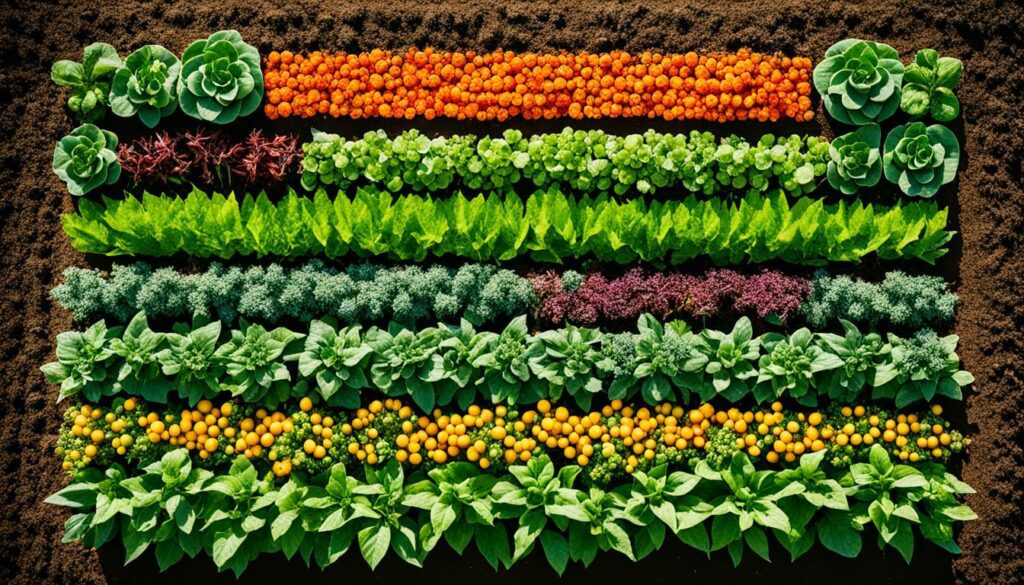
Since the 1900s, around 75% of plant genetics have disappeared, mainly due to choosing the same high-yield types everywhere. Today, as much as 30% of livestock types could vanish. Six breeds are lost every month. This threatens our food supply and the ability of farms to adapt.
Today, we’re learning how important it is to have many kinds of plants and animals on farms. Mixing up different crops and animals helps farms fight off pests, diseases, and bad weather. It also keeps the gene pool rich for future crops.
New ways of farming include growing more kinds of plants to avoid some of the problems linked to growing just one thing. For example, planting different types of crops can help save fish by lowering overfishing. It also protects wild areas, which stop the loss of plant and animal types that farms need to be healthy.
The UN Food Systems Summit 2021 is looking to change how we make and eat food with smart new approaches. By 2030, these changes could be worth a lot of money, up to $5.7 trillion every year. Investing in agro-biodiversity now is key to a future where farming is both good for us and the planet.
Creating the right conditions for biodiversity means focusing on strong policies and getting everyone involved. By setting smart conservation rules and rewarding choices that help nature, we can better care for our planet.
Good policies play a big role in helping nature. Policies should fit the area they cover and offer rewards for helping biodiversity. For example, making sure more people buy FSC or Rainforest Alliance-certified products can push for greener habits.
It’s important to pay farmers to look after nature. Since a lot of wildlife lives on farms, we need to help out. Giving farmers money to plant native species and use less harmful chemicals can make a big difference for many plants and animals.
It’s key to get local people and farmers involved. Efforts to save nature work best when those living nearby help decide what to do. We should blend local wisdom into big nature-saving plans to make them truly work.
Working together with the community is essential to protect certain animals. Bees, for example, are in trouble with numbers falling sharply. Yet, 90% of the plants they pollinate need the bees to survive. So, everyone’s help is needed to keep these essential pollinators going strong.
Let’s look at some numbers that highlight the need for everyone to get involved:
| Biodiversity Indicator | Percentage/Rate |
|---|---|
| Global biodiversity loss due to habitat destruction | 75% |
| Decline in bee populations | 30% annually |
| Positive demand shift for native plants | 15% |
| Forest products from unsustainable sources | 50% |
| Endangered species at risk due to habitat destruction | 1 M |
Combining good policies with the efforts of those who care can really help nature. This approach not only protects ecosystems but also keeps our lands healthy for the people of tomorrow.
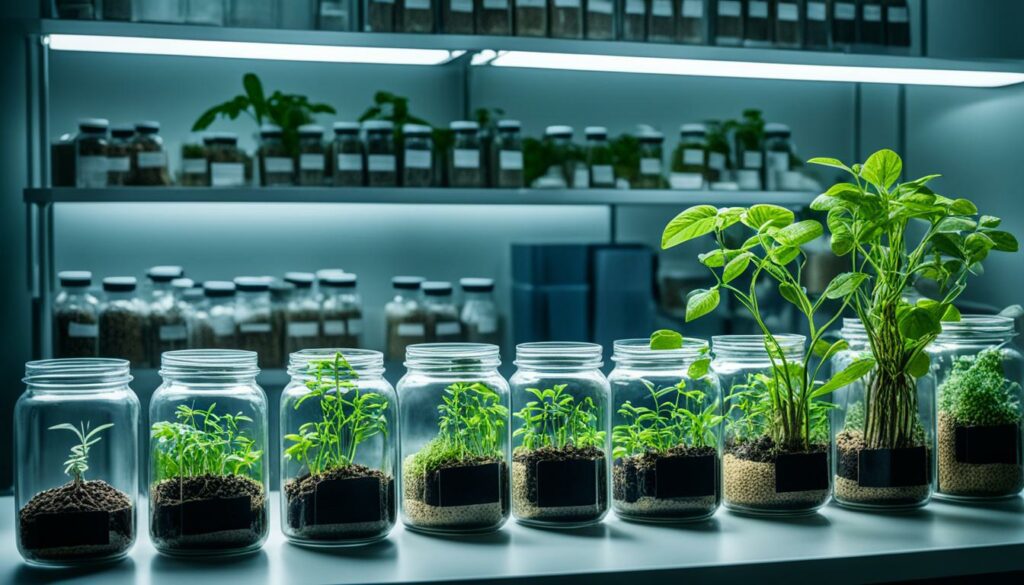
Genebanks are vital for saving plant types around the world. Yet, they face many risks and challenges. These must be well dealt with to keep them running and protect what they store.
Natural dangers can harm genebanks. An assessment of 80 genebanks found they are in danger from quakes, storms, and floods. In 2011, Thailand lost a lot of special rice types when a flood hit. Also, the Philippines’ genebank dealt with floods in 2006 and a fire in 2012. These sad events show why we need strong plans to cut the harm from nature.
Changes in politics and money can also be a big problem. Genebanks in Africa might face more political issues. Banks in Asia and the Pacific might deal with nature’s dangers more. For example, the ICARDA genebank had to move in 2016 because of the war in Syria. The seed bank in Ukraine moved in 2023 because of the Russian invasion. These moves show how important it is to plan ahead with backup plans and ways to stay safe even in hard times.
To fight these problems, genebanks need to take action. They can make their buildings stronger and keep extra copies of their plant samples. They can also use things like insurance and save money for emergencies. For these to work, genebanks must know exactly what they’re keeping and how much it’s worth. The Svalbard Seed Vault is an important backup for seeds from around the world. But even it faced problems in 2022 because of climate change. This shows we must always be ready to change and watch out for new risks.
Managing risks well in genebanks means we keep our global food supply and farming strong.
| Risk Factor | Impact | Examples |
|---|---|---|
| Natural Hazards | Damage to collections | Thailand (2011 flood), Philippines (2006 flood, 2012 fire) |
| Political Instability | Relocation and disruption | ICARDA (relocated 2016), Ukraine (relocated 2023) |
| Financial Constraints | Operational risks | Underutilisation of insurance schemes |
Using many different types of plants in farming is key for better health of ecosystems and more stable economies. Studies at the University of Kansas show that planting a variety of crops can increase the harvest. It can also keep the soil healthier by fighting off bad pathogens.
Mixing up the plants we grow doesn’t just grow more food. It makes the soil less friendly to things that harm plants. This leads to more growth and better food. Researchers highlight that using different plant types together can keep the plants healthier.
Research findings suggested that traditional monoculture practices could benefit enormously from adopting diverse planting techniques such as crop rotation.
| Benefits | Details |
|---|---|
| Increased Yield | Diverse plant species manage pathogens better, leading to higher productivity. |
| Pest and Pathogen Control | Alternating rows of different crops show decreased pathogen growth compared to monocultures. |
| Economic Viability | Producers save on crop protection products, enhancing financial sustainability. |
| Enhanced Nutrient Availability | Plant communities with diverse species produce a wider variety of exudates, promoting nutrient uptake. |
Having different plants also brings in helpful insects and pollinators. They keep our air, water, and soil clean. Some plants even have compounds that protect the others. This makes for healthier farms.
Different plants create a more varied diet for farm animals too. This makes the animals stronger and less likely to get sick. So, mixing up plants does a lot of good. It helps the land, the food, and the animals. This makes farming safer and better for the future.
The safeguarding of crop diversity in the future needs new ways to keep seeds safe. These ways must be used all over the world. The Svalbard Global Seed Vault has already collected over 1 million different seeds and could store up to 4.5 million. This is important in case anything happens to the 2.3 million different crops in genebanks worldwide.

The Crop Trust has played a big part in this. It started 20 years ago and aims to get USD $850 million to protect seeds. It now has USD $300 million. This money is very important to run the genebanks storing seeds. It shows we all need to work together to keep our seeds safe.
Many countries promise to help, following the United Nations goals. Even our food choices can help protect different crops. More than 45 important people in food have written about this to show its importance.
Over 150 countries have agreed to the Plant Treaty. This treaty helps protect and share crops fairly. Projects like BOLD also show ways to protect crops well. They make sure there are enough different seeds for our future needs.
In 2024, the World Food Prize was given to Dr. Geoffrey Hawtin and Dr. Cary Fowler. Their work is a great example of protecting different crops. This shows the new ways to keep our seeds safe. They encourage more people to help in keeping our crops safe too.
The farm industry faces threats like bugs and diseases. These can cause big money losses. For example, soybean rust could mean losing USD $1 billion every year. And potato blight already costs USD $400 million a year. In the US, pests and diseases on plants cost USD $20-$33 billion a year.
It’s crucial to have many different seeds to grow strong plants. This helps make good food that’s better for us and the planet. Looking forward, we must focus on protecting our crop diversity. This way, we can grow food that’s better and safer for everyone.
Looking back, it’s clear how crucial plant diversity is. It’s vital for the world’s food, the environment, and our economy. The impact of plant variety goes far beyond just more crops. It also helps keep ecosystems healthy, supports rural jobs, and looks after our planet.
As our world sees more people and uses up resources faster, getting enough food is harder. Challenges like the Covid-19 pandemic and the Ukraine war have made global food security more urgent. They’ve made it tough to get food, find farm workers, and export crops. With food export limits due to the Ukraine conflict, about 15.7% of the world’s traded food is at risk. This shows how delicate our food chain is.
Climate change makes growing food and protecting wildlife tougher. Farming is a big reason nature is shrinking, and it gives off lots of harmful gases. So, we need to farm in a way that helps nature and grows food well. This includes using land better, boosting the good things nature does, and planting a wider variety of crops and wild plants. Doing this helps us maintain a good food supply and nature together.
In the end, we see why plant variety really matters. Working together to care for and use a wide range of plants is key. It’s how we can tackle climate issues and feed more people. With a focus on plants, we can make our food supply strong, ready for any challenges, and lasting for the future.
Habitat degradation, climate change, and intensive farming impact biodiversity. This leads to a loss of plant types. Monocultures replace variety, reducing the ability of crops to respond to stress.
Economically, biodiversity loss affects farm income and food safety. Environmentally, it weakens soil health and disrupts natural pest control. This reduces the health of whole ecosystems.
A mix of plants helps agriculture deal with climate shifts and extreme weather. This variety boosts genetic resilience against pests and diseases. It makes farming systems better withstand climate change.
Growing a variety of crops improves the nutrients in our food. It ensures we get a mix of vitamins and minerals for our health.
Diverse fields help with pollination and keep pests in check naturally. This means less use of chemicals, which is good for farms and the surrounding environment.
Crop variety ensures we have enough food, even with changing conditions. It helps create new, stronger plant types able to fight off diseases and survive droughts.
Genebanks protect the world’s seeds for future farming. They are key in keeping a wide range of crops available for difficult times.
Genebanks have to deal with natural disasters, political changes, and financial issues. To manage, they use various methods like creating duplicates and having emergency funds.
The Svalbard Global Seed Vault is a top example of a well-run genebank. It secures seeds from across the globe, helping in worldwide conservation efforts.
In situ conservation keeps crop variants within their natural habitats. On-farm conservation relies on practices passed down through generations to maintain diverse crops. Both help plants adapt to changes and thrive over time.
The ecosystem approach looks at farming as part of a interconnected system. It seeks to use nature in a way that also protects it. There are 12 main ways to do this, including not disturbing natural balances and keeping farms diverse.
Monocultures limit the types of plants grown, making food supplies at risk. They make crops weaker against diseases and the land less healthy. This could lead to needing more chemical help to grow food.
Having many different types of crops means farming is more ready for climate issues. These plant mixes can resist new diseases and pests. This makes the whole farming system stronger and more able to cope with different weather.
Perennial crops help the environment by reducing pollution and providing homes for helpful insects. They also make the soil healthier. Though they might not make as much money, these plants are important for a sustainable future in farming.
Agro-biodiversity is the many plant and animal species found in farming. It’s essential for a healthy farming system. Keeping these diverse plants and animals helps farming survive and supports nature.
To help biodiversity, we need flexible rules that encourage nature-friendly farming and involve local people. This means finding unique solutions that help keep nature rich, even in farmed areas.
Genebanks can protect their seeds by updating their safety measures and using smart risk planning. This includes strengthening buildings, making copies of seeds, and having emergency plans in place.
A rich variety of plants is the backbone of healthy farming and a stable food future. It ensures our meals are balanced and the land we grow on stays productive without over-relying on chemicals.
Protecting the many types of crops needs us all to work together and use new, smart approaches. This is vital as challenges like climate change and growing populations put more pressure on our food supplies.